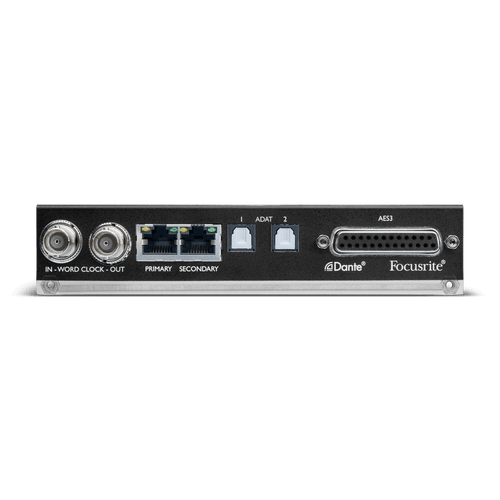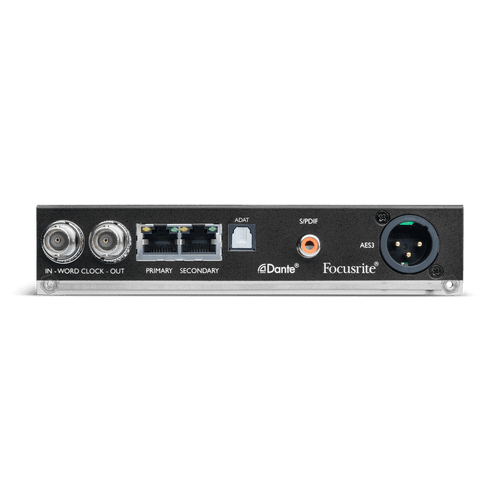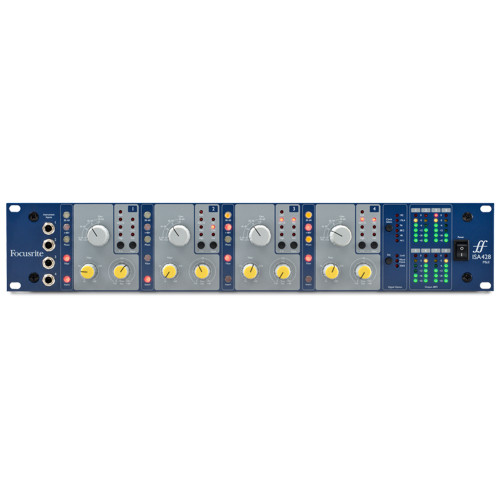Overview
The ISA Story goes back to 1985, when Sir George Martin commissioned legendary designer Rupert Neve to design new modules for the console at AIR Montserrat. They were so successful that more were commissioned for AIR London. These original modules form the basis of today’s Focusrite ISA range – delivering the legendary Focusrite sound to leading studios, artists, producers and engineers around the world. Literally hundreds of hits have been made with the Focusrite ISA Range – and continue to be made today.
Features
-
Lundahl LL1538 mic input transformer
-
Up to 80 dB of gain
-
Variable input impedance
-
User-calibrated metering
-
Front panel instrument and rear panel line inputs
-
Variable cut-off high-pass filter
-
Rear panel balanced inserts
-
XLR-F mic inputs
-
1/4" TRS line inputs
-
1/4" TRS Sends
-
1/4" TRS Returns
-
XLR-M line output
-
Single peak meter calibration dial
-
Single IEC power socket
-
1/4" instrument input
-
Variable input impedance - Low, ISA 110, Medium, High
-
Input selection - Mic, Line, Instrument
-
0 - 30 dB/30 - 60 dB gain switch
-
Phantom power switch
-
Phase invert switch
-
0 - 60 dB gain in 10 dB steps
-
0 - +20 dB continuously variable trim
-
Variable high-pass filter with on/off switch
-
Insert point on/off switch
-
Eight-LED user-calibrated level meters
-
Single power switch
Specifications
| Maximum Input and Output Levels | |
| Maximum Output Level | +24 dBu with a THD+N < 0.01% at 1kHz measured with 150 Ω source impedance and 22Hz/22kHz band-pass filter |
| Maximum Microphone Transformer Input Level | +7 dBu with a THD+N < 0.7% at 1kHz measured at 0 dB of gain with 150 Ω source impedance and 22Hz/22kHz band-pass filter |
| Mic Input Response | |
| Gain range | 0 dB to +60 dB in 10 dB steps, plus 0 dB to +20 dB continuously variable trim |
| Input Impedance | Switched Impedance setting |
| Equivalent Input Impedance at 1 kHz | |
| EIN (Equivalent Input Noise) | Measured at 60 dB of gain with 150 Ω source impedance and 22 Hz-22 kHz band pass filter |
| Noise | Noise at output with unity gain (0 dB) and 22 Hz-22 kHz band pass filter |
| Signal-to-Noise Ratio | Measured with 150 Ω source impedance and 22 Hz-22 kHz band pass filter |
| Total Harmonic Distortion + Noise | Measured with a -20 dBu input signal at +30 dB of gain and with a 22 Hz-22 kHz band pass filter |
| Frequency Response | At minimum gain (0 dB) |
| At +60 dB gain | |
| CMRR (Common Mode Rejection Ratio) | -94 dB for mic input at 60 Hz for max. output = +24 dBu |
| -91 dB for mic input at 10 kHz for max. output = +24 dBu | |
| Crosstalk Channel to Channel | Mic input, with I/P = 0 dBu, gain = 0 dB @ 1 kHz input to channel A, channel B output = -85 dB |
| Line Input Response | |
| Gain range | -20 dB to +10 dB in 10 dB steps, plus 0 dB to +20 dB continuously variable trim |
| Input Impedance | 10 kΩ from 10 Hz to 200 kHz |
| Noise | Noise at main output with gain at unity (0 dB) measured with 50 Ω source impedance and a 22Hz - 22 kHz band pass filter |
| Signal-to-Noise Ratio | Measured with 50 Ω source impedance and a 22 Hz-22 kHz band pass filter |
| Total Harmonic Distortion + Noise | Measured with a 0 dBu input signal, +10 dB of gain and a 22 Hz-22 kHz band pass filter |
| Frequency Response | At minimum gain (0 dB) |
| Crosstalk Channel to Channel | Line input, with I/P = 0 dBu, gain = 0dB @ 1 kHz input to channel A |















